Abstract
Nowadays, the world has focused on digital media. There have been voices for and against virtual education. Gamification has been described as a strategy to transmit knowledge through the design and use of games. This article describes the first phase of the development of a game aimed at the transmission of knowledge related to engineers dedicated to the commercialization, diagnosis, and repair of induction motors; these are electrical machines widely used in industry. In this way, this paper shows the Electric Motor Store Simulator (hereinafter STME for its acronym in Spanish) is a free software project that aims to develop a game for users to have a closer idea about small businesses. It was developed as a minimum viable product under free software licensing, which allows anyone with the necessary knowledge to expand the functionality by adding or improving modules.
Keywords: Gamification, three-phase motor, teaching virtual tools, simulator
1. Introduction: The importance of electrical machines laboratories
The profile of the average technical characteristics of the computers used by future users of the STME (mostly teachers and students) was determined to estimate the recommended technical characteristics that the minimum viable product should have. Second, the predispositions of a sample of the educational community that will use the software (40 students and 22 teachers) about their expectations about the future in education are studied; this was based on some of their consumption patterns and how they value their current activities.
During the development of the STME, whose minimum viable product was completed a month and a half, basic models were used to recreate the fundamental aspects of an SME: generating income from the sale of electric motors and meeting its obligations (such as payroll, leases, specialized cleaning services, and bank loans).
This project intends to be socialized so that the academic community can use it or improve it by including more advanced models that describe the day-to-day life of an SME in a more realistic manner.
According to the International Labor Organization, issues relevant to sustainable development and environmental sustainability are fundamental pillars for everyone to have a decent job. The ILO emphasizes that a good part of green jobs will lead to more qualified, safer and better paid jobs [1].
Carmona and Díaz indicate that the development of telecommunications has boosted the demand for professionals who develop diagnoses, installations, and repairs; these professionals should have the necessary knowledge of the application and operation of the electrical circuits they will handle in their working lives [2].
Electricity, as a driving force, was used massively since the beginning of the 20th century. Compared to other energy sources of that time (hydraulic power led industries to locate their facilities near rivers, and the use of steam generated gaseous waste), electricity had a cleaner use and made it possible to establish industrial zones whose locations had not been considered a few decades earlier. Chapman points out that electric motors ensure the operation of all types of appliances useful in both domestic and industrial use [3].
Electrical machines have been used since then. Due to the danger of improper handling, their use and maintenance have been delegated to qualified personnel. Laws and regulations were enacted to prevent accidents and bad practices related to this activity. The Technical Regulations for Electrical Installations (RETIE for their acronym in Spanish) are the mandatory legal framework applied to professional electricians in Colombia [4].
As a conclusion of this section, electrical machine laboratories are a response to society’s need to create safer and more efficient devices and to contribute to the reduction of emissions at energy generation points and to the welfare of company employees. Electrical machine laboratories are essential to the transmission of practical knowledge in academic centers. By employing machinery and power devices used in industry, students have their first experiences with devices that are very similar to those they will handle in the course of their work.
Currently, there is a trend to implement simulators in higher education institutions. These are used to recreate operations that can significantly reduce the service life of laboratory machines and cause accidents to students [5].
2. Materials and methods: Video game need survey for development
The development strategy of the structured analysis and the classic life cycle of systems are considered to develop the game. Senn states that, in its initial phase, software development uses tools for obtaining information from potential future users [6].
Three surveys were used to obtain data. The first survey was aimed at obtaining the average technical characteristics of the computers used by both teachers and students. Respondents described the most relevant features of their computers; the average profile could be summarized as follows:
- Laptop
- Windows operating system (current version is Windows 10)
- 8 Gb RAM
- 800 Gb-1 Tb hard driver
- Internet connection through WiFi
A computer that can be purchased in the market with these features has an Intel I5 or an AMD Ryzen 5 processor. In Gómez [7], the author gives a detailed description of the implications of their use in equipment designed for video games and concludes that other features (such as RAM speed or a specific graphics card) should be considered [7].
The device used by all the respondents is the computer; most of them explained that the skills necessary to use it were developed on their own.
The second survey was aimed at teachers to obtain information on the devices used in teaching and evaluation tasks.
More than 70% of teachers claim that grading tasks are performed by themselves. 90% of the teachers surveyed believe that evaluation methodology and criteria will change in the next ten years; this trend can be explained by recalling the changes that have occurred over the last ten years.
There is a consensus among teachers on some aspects: almost all of those surveyed estimate that fortuitous events will occur that will force them to teach their classes in a different way than they are used to. Figure 1 shows that no teacher contemplates the possibility of preserving current conditions; advances in technology and social circumstances have resulted in a dynamic expectation and uncertainty about teachers’ working conditions in the future.
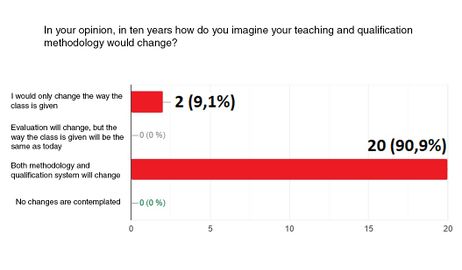
|
| Figure 1. Example of results obtained in the survey applied to teachers. Source: the authors |
The role of online courses and training provided by the institution where they work, as a means for teachers to gain knowledge and feel that they are at the forefront, is very important. These were the two most voted options: there is knowledge that can (and should) be developed through an online course, but certification of knowledge is also necessary (certificates could be a proof of acquired skills).
The third survey was designed for students to mention their preferences about the games they have played and their ideas about the skills developed through them. The first question was focused on determining the existence of a preference for a certain type of game; however, the results showed a distributed predilection for strategy games, simulators, shooters, open world games, and role-playing games (Figure 2). Most of them use computers for their operation. Their contemporary versions require equipment with more advanced features than average programs.
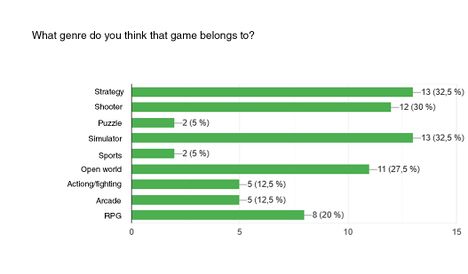
|
| Figure 2. Example of results obtained in the survey applied to teachers. Source: the authors |
It is interesting to note that most of the respondents claim that the games have allowed them to gain knowledge that can be applied in everyday life. Even so, they are reluctant to create or join communities that carry out competitions and/or tutorials. Faced with the possibility of having a software program that recreates environments closer to reality, both in their careers and in other aspects related to their studies, students indicate that a game can be used as an evaluation tool in the future for them to obtain a grade according to their performance..
3. Results
During their undergraduate studies, students from most universities may attend events where they come into contact with large companies that launch internships or recruit new talent. In most of the students’ life projects, the expectation is to obtain a job in a large company that can guarantee them job and financial stability.
Rarely do small companies participate in these kinds of events. As part of a life project, students seldom express their desire to join the payroll of an SME (much less found it). The STME was developed to show the dynamics of an SME, so its development stages are the following:
- To develop the base software: establishment of basic business simulation models.
- To open the source code: refinement of base software models and creation of business models.
The development of the base software took a month and a half. Visual Basic 2019 version was used; the compiler (Community version) allows further editing of the STME source code (if it remains a free software project). The main advantage of the STME is that it can recreate the basic behavior of a company in a very short period. This is an advantage that makes it an ideal academic tool that allows the teacher to address topics during classes.
The STME is designed under a Tycoon perspective, so that users can recreate some of the functions that they would have if they were managers of a company that commercializes electric motors. It can be defined as a simplified model of a company. Simplification is an appropriate strategy for gamification as the user will have a more enjoyable experience. Players perform the activities they deem necessary during the day, then tells the STME that they wish to move on to the next day. To do this, the player navigates through the main window, the office, the workshop, and the store. Figure 3 shows the home screen of the game.
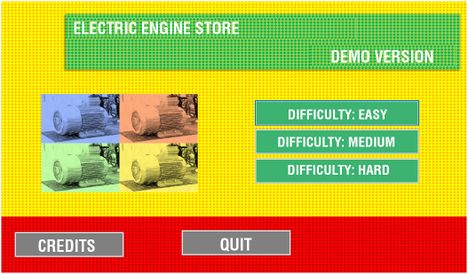
|
| Figure 3. STEM start menu. Source: the authors |
Payroll payments, cleaning services, investments in machinery, and bank loans are managed from the office function (Figure 4).
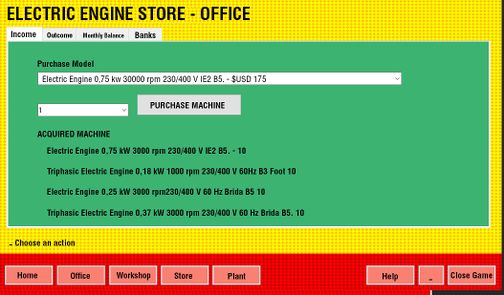
|
| Figure 4. STME office window. Source: the authors |
From the store window, users can know the unit price of each machine model, set the desired profit percentage on sales, and know the number of machines sold during the days of the month and the total monthly sales (Figure 5).
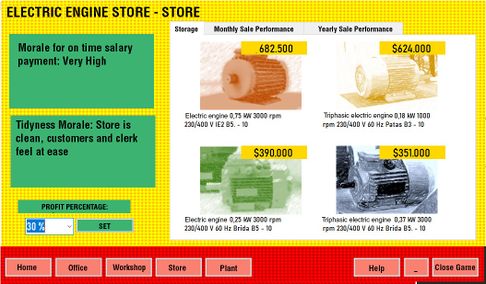
|
| Figure 5. STME store window. Source: the authors |
In the workshop window, users can observe how the vacuum and locked rotor tests of electric motors are carried out. With a single click, the Engineer shows how the tests are performed step by step (Figure 6).
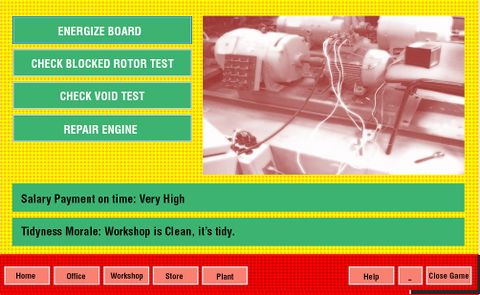
|
| Figure 6. STME workshop window. Source: the authors |
Users can earn money by selling electric machines (there are four models available), which must be obtained abroad (purchased in dollars). Sales must be made in Colombian pesos; the volatility of the dollar/Colombian peso exchange rate is a constant that many companies deal with. Users can obtain a loan from a bank in case they run out of funds.
The STME has three levels of difficulty; depending on their choice, players will have a starting capital, machinery in storage, or simple, moderate, or high rental payments. There is a trend observed in recent years by assimilating characteristics of other existing games on the market: users are awarded medals. For example, Figure 7 shows a menu defining the mission to be developed and the medal obtained. The lower part shows the condition to be met in order to obtain a certain medal.
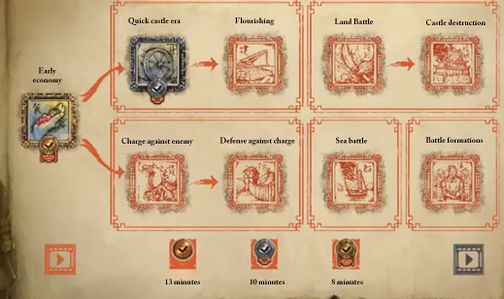
|
| Figure 7. Menu “The Art of War” from Age of Empires 2 [online]. Available at: https://www.youtube.com/watch?v=E0s0rxiXMKI Accessed on April 16, 2021 |
The STME has a similar medal table (Figure 8). The conditions for the user to obtain the medals depend on the quantity and the deadline for the completion of a mission.
The main activities in the minimum viable product consist of payroll, credit payments, leases, and the number of electric motors purchased or sold. The medals intend to motivate users to develop the missions until they achieve optimal performance.
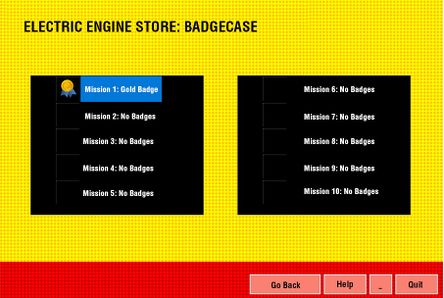
|
| Figure 8. Medal table included in the STME. Source: the authors |
The income must be used to pay the main expenses: payroll (consisting of Manager, Engineer, and Salesman), rent of facilities (consisting of an office, a store, and a workshop), cleaning services, and bank installments.
4. Discussion
Under current plans, the full development of the STME would include two aspects: the refinement of current modules (to simulate more realistic behavior) and the construction of new modules.
An example of a current available module to be refined is the modeling of a corporate bank loan. In real life, entrepreneurs can select one of different banks, which are regulated and compete by offering more favorable conditions than their competitors. Generally, business loans are made based on total capital and credit history.
It is also intended that in complete game allows the user can assume a single role within the company, automating the other aspects (as a manager, as a salesperson, or as an engineer). In this way, it is possible to implement a model focused on the technical aspect (allowing the user to directly perform tests and/or repairs to electrical machines), on management (considering other accounting aspects more in line with IFRS regulations, customs regulations, among others), or on sales-related aspects (applying more popular sales methods).
In the manager role, in addition to managing income and expenses, it would be convenient to consider the criteria for personnel selection through a module specialized in this aspect.
Sales in the store could be expanded to include other goods and services, and contemporary features, such as the use or non-use of social networks and online stores, could be implemented. A wider variety of electrical machines and repairs in other cities of the country could also be included.
Based on features of strategy games, a tree of technologies will be added to improve manager and employee performance and to recreate the desirability of ongoing staff training. In real life, job applicants have a set of skills and deficiencies that can be honed (both for better and worse) through training and the acquisition of capital equipment. The payroll included in the game could increase by adding more jobs.
The recreation of externalities (such as damage to machinery and adverse economic situations) could help analyze strategies to reduce their impact. It is necessary that these simulations allow users to simulate similar situations and to obtain different results in each interaction with the game.
It is possible to recreate some situations that future business administrators can solve with “textbook recipes” by estimating an emergency situation within a company and by refining the simulation of situations beyond the control of managers (such as the value of the dollar and employees’ medical leaves).
The scope of the STME will be expanded to cover topics related to other degrees by refining and/or adding specialized modules. For example, future public accountants and business administrators can put their knowledge of IFRS standards into practice. To achieve this, it is necessary to discriminate the income and expense model of the game in a different way and adjust it to make the accounting processes more complex.
5. Conclusions
The study of the nature of work performance in SMEs should gain greater relevance, either to learn about their management or to become an employee in one of them. A recommended strategy is the development of simulation projects to recreate existing conditions and to facilitate the transmission of information.
Current conditions have led to uncertainty and major changes in the way teachers and students relate to each other in the process of transferring information and conducting assessments.
The consumption of video games by teachers and students, together with the acquisition of more powerful computers, has expanded the coverage of technological means sufficient for each of them to have a computer for virtual practices.
An open-source project resulting in a minimum viable product, such as the development of the STME, will serve as a basis for refining models included in it. In the long run, collaboration between users and developers will help expand the functions of the simulator.
One of the general ideas is to collaborate with different faculties and to make the STME a point of convergence with the aim of giving an academic description of SMEs that is much closer to the real one. In a country like Colombia, where small and medium-sized companies are the choice of many professionals and their source of employment, it is necessary that universities bring students closer to their reality.
Both the development of the specialization of the work within the STME and the Engineer role can merge the relevant aspects of testing, diagnosis, repair, and commercialization of goods and services related to electrical machines. Given the rise of e-commerce, the STME might include modules for future electrical engineers to learn about contemporary techniques so that they can offer their services.
References
[1] Organización Mundial del Trabajo. Conferencia Internacional de trabajo, 102° reunión. Informe V. El desarrollo sostenible, el trabajo decente y los empleos verdes. Oficina Internacional del Trabajo, Ginebra, 2013.
[2] Carmona G., Díaz T. Electrónica aplicada. Ed. McGraw Hill, Madrid. 2010.
[3] Chapman S. Máquinas eléctricas. México D.F., Ed. McGraw Hill, 5a Ed., 2012.
[4] República de Colombia – Ministerio de Minas y Energía. Reglamento Técnico de Instalaciones Eléctricas RETIE, Bogotá D.C., 2013.
[5] Bautista G., Borges F., Forés A. Didáctica universitaria en entornos virtuales de enseñanza - aprendizaje. Ed. Narcea S.A., Madrid, 2006.
[6] Senn J. Análisis y diseño de sistemas de información. México D.F., Ed. McGraw Hill, 1992.
[7] Gómez B. Intel Core i5-10400 vs AMD Ryzen 5 3600: comparativa de CPU de gama media [online]. Disponible en: https://www.profesionalreview.com/2020/09/18/intel-core-i5-10400-vs-amd-ryzen-5-3600-comparativa-de-cpu-de-gama-media/. Consultado: 16 de abril 2021.Document information
Published on 01/04/22
Accepted on 17/03/22
Submitted on 08/11/21
Volume 38, Issue 2, 2022
DOI: 10.23967/j.rimni.2022.03.013
Licence: CC BY-NC-SA license